I love twin-lens reflex cameras, and consider the venerable and
near-extinct TLR to be the ne plus ultra of camera design
configuration. For me, the combination of whisper-quiet operation,
low vibration (thanks to a minimum of moving parts), and the facility
to compose one's shot on a two-dimensional ground glass screen's full
negative-sized preview of the photograph (albeit reversed) rather
than peering through a viewfinder or single lens reflex pentaprism
made and still makes the TLR a pleasure to use.
When I made part of my living as a wedding and portrait
photographer back in the 1970s, my workhorse camera was a Rolleicord
Vb twin-lens reflex (TLR), the no-frills, entry-level version of the
wonderful Rolleiflex. With its razor-sharp Schneider Xenar lens and
2-1/4" square (6 x 6 cm) negative format, that old Rollei recorded
many superb images.
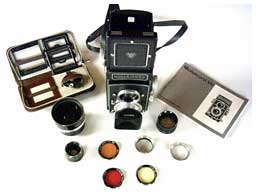 I
even have an optional conversion kit that allows the big Rollei to
take 15 35mm-sized or square "Superslide" exposures on 120 roll film
rather than the standard 12, a wide angle adapter, two diopters of
parallax-corrected close-up lenses, and a few filters.
I
even have an optional conversion kit that allows the big Rollei to
take 15 35mm-sized or square "Superslide" exposures on 120 roll film
rather than the standard 12, a wide angle adapter, two diopters of
parallax-corrected close-up lenses, and a few filters.
From its introduction in 1928, the Rolleiflex was the camera of
choice for professionals - and for many advanced amateur
photographers as well - for over 30 years.
Because you look down into the ground glass hood, you could stand
facing one direction with the camera pointing elsewhere - great for
candid work! The crude-but-effective "sports finder" - basically
open gun sight apertures in the focusing hood, work well for action
shots more than 20 feet away. And because the negative is square,
there is no time lost deciding between horizontal or vertical
composition.
However, the skill required to cope with the reversed focusing
image, plus parallax errors in close-up work caused by the viewing
and taking lenses being in separate planes, and the fact that the TLR
Rolleiflex did not offer interchangeable lenses, caused it to lose
ground to the heavier, noisier, more expensive, much more
mechanically complex single lens reflex Hasselblads, Bronicas,
Mamiyas, and ultimately Rollei's own medium format Rolleiflex SL 66
and SLX SLRs, not to mention the shift of 35mm from being regarded as
a "minicam" format to the de facto mainstream standard.
The Rolleiflex TLR has never really gone out of production, and
you can still buy one new today, albeit at an astronomical price. It
is now more or less a special interest collector's item, although a
highly functional one still capable of taking superb photographs.
The current line of Rolleiflex
2.8FX and 4.0FW (wide-angle) cameras are classical twin-lens
reflex cameras with the advanced exposure-control options of a modern
Rolleiflex. State-of-the-art TTL metering and autoflash control are a
combination of tradition and progress. In all other respects, the
classic Rollei's time-tested features have been preserved, such as
the folding crank advancing the film with a rapid back-and-forth
movement while at the same time setting the shutter and stepping the
frame counter without making multiple exposures impossible.
I had sadly resigned myself to the TLR being a relic as far as the
consumer market is concerned, but perhaps that was a premature
deduction.
Or perhaps not.
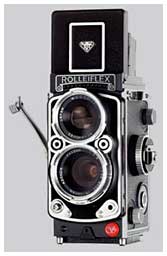 Last
week a new Rollei camera was announced that will hit the U.S. market
in November, and mirabile dictu, it's a twin-lens reflex that
is the spitting image of the classic Rolleiflex with two lenses, one
above the other; a hand crank lever; a hooded viewfinder; a bright
metal accented coal-black casing; and the Rolleiflex logo.
Last
week a new Rollei camera was announced that will hit the U.S. market
in November, and mirabile dictu, it's a twin-lens reflex that
is the spitting image of the classic Rolleiflex with two lenses, one
above the other; a hand crank lever; a hooded viewfinder; a bright
metal accented coal-black casing; and the Rolleiflex logo.
What's different is that it's much smaller and digital.
Much as auto manufacturers who have applied modern technologies to
classic designs - such as the Jaguar "S" type, Ford's retro
Thunderbird, or the Volkswagen New Beetle - the new Rolleiflex
MiniDigi has the look and feel of the original, but it fits in the
palm of your hand or in your pocket.
The hand crank is functional, but instead of advancing film (which
it doesn't use), the MiniDigi's crank prepares the camera for the
next shot. The classic popup hood and viewfinder also provides the
original's "Sportsfinder" function for quick framing of action shots.
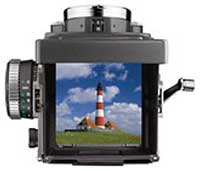 However,
the viewfinder screen uses a color LCD instead of a ground glass, and
the image is not reversed. With this type of viewfinder, you can also
hold the camera very low or even place it on the ground when the shot
requires that - and you don't have to lie flat on your belly
yourself.
However,
the viewfinder screen uses a color LCD instead of a ground glass, and
the image is not reversed. With this type of viewfinder, you can also
hold the camera very low or even place it on the ground when the shot
requires that - and you don't have to lie flat on your belly
yourself.
Happily, the Rolleiflex MiniDigi uses a a square picture format,
just like the film Rollei TLRs. The square format means no shutter
opportunities or valuable seconds are lost choosing between
horizontal or vertical composition. Just look down into the
viewfinder at waist level, aim, and shoot. This is much less imposing
and intrusive for candid shots, portraits, or taking pictures of
babies or animals, because the eyes of the photographer and the
subject don't meet.
Very cool, but there are some disappointing aspects as well. While
the MiniDigi incorporates digital camera technology, including SD
memory cards, white balance, and fast shutter speeds, it has a very
pedestrian (by current standard) 2 megapixel sensor that offers only
modest resolutions of 1760 x 1760, 1280 x 1280, or 640 x 640 pixels.
The manufacturer concedes that it's really more of a conversation
piece and collector's item, and not really intended to be a
full-featured digital camera.
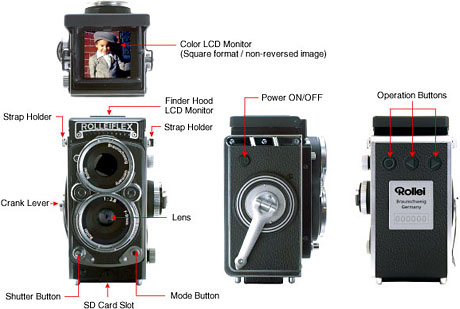
Megapixels are not the only factor in rendering high digital image
quality. The lens is probably of greater practical importance. The
MiniDigi has a five element lens, but more technical details are not
provided, and it's fixed-focus, which doesn't speak "serious
camera."
"While the MiniDigi, because of its size, doesn't have some
features like USB or flash, it does have a unique, retro styling that
will likely appeal to camera buffs and consumers who want something
classic, original, fun, and extremely portable," Dick Dischler, who
is in charge of US distribution for Rollei Logistics, noted in a
press release. "The MiniDigi has really taken off in Japan where the
first reaction is often 'this is really cool.'"
Cool-looking, yes, but what a shame they didn't go the distance
and make the MiniDigi a premium photographic performer in the
tradition of its inspiration and namesake. What this camera needs is
a 4 or 5 megapixel CMOS. Now that would have been something to
get really excited about.
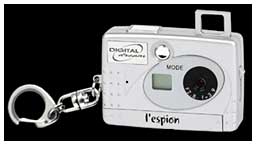 I
mean, no USB? What's that about? Even my tiny, $49 Digital
Dream l'Espion has USB support.
I
mean, no USB? What's that about? Even my tiny, $49 Digital
Dream l'Espion has USB support.
The new Rollei will begin shipping in early November and be
available through specialty retailers. Pricing is expected to be in
the $350 range.
Technical data in Appendix below.
Rollei Logistics,
based in Tokyo, is under contract with Rollei Fototechnic GmbH
Germany to manufacture the Rollei MiniDigi in Japan and to distribute
the camera in the U.S.
Classic Leica M3 4 Megapixel Digital Camera
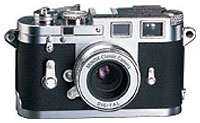 If
you like the concept of retro-styled digital cameras but want a
high-quality lens and decent resolution, check out the digital
classic camera Leica M3 from highly respected German optical and
miniaturization specialists Minox.
It's not a twin-lens reflex, but it does offer both gorgeous retro
styling and modern photographic performance
If
you like the concept of retro-styled digital cameras but want a
high-quality lens and decent resolution, check out the digital
classic camera Leica M3 from highly respected German optical and
miniaturization specialists Minox.
It's not a twin-lens reflex, but it does offer both gorgeous retro
styling and modern photographic performance
"Finding a niche in the constantly growing and increasingly
competitive digital camera market" was, according to Minox General
Manager, Thorsten Kortemeier, the "major goal" set by this
traditionally minded company based in Wetzlar, Germany.
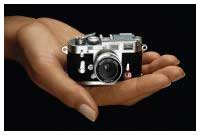 This
has been accomplished by Minox with their digital replica of the
classic Leica M3 camera in its ultra miniature format, which now has
a 4.0 megapixel CMOS, providing the user with sharper recorded images
and more detailed rendition captured by its f/2.8 five element glass
lens. This latest model from Minox maintains the company's
traditional values of features and fine mechanical precision built
into ingeniously compact design.
This
has been accomplished by Minox with their digital replica of the
classic Leica M3 camera in its ultra miniature format, which now has
a 4.0 megapixel CMOS, providing the user with sharper recorded images
and more detailed rendition captured by its f/2.8 five element glass
lens. This latest model from Minox maintains the company's
traditional values of features and fine mechanical precision built
into ingeniously compact design.
The Minox Digital Classic Camera Leica M3 is intended to be both
easy to use and ideal for those getting started in the field of
digital photography who like classic convention rather than high-tech
looks.
Up to 99 images can be recorded on the internal 32 MB memory. The
camera includes a USB interface for transferring of images onto a PC
or Mac. The LCD display on the camera back provides information on
the number of images left to shoot at any one time.
The tiny dimensions of the Minox DCC Leica M3 make it pocketable,
and functional both as a camera and a digital notebook. The optional
classic electronic flash compliments the style and design of this
unique camera.
System requirements:
- Microsoft Windows 98SE/ME/2000/XP/Mac
- 64 MB RAM
- Video with 2-MB-RAM for displaying at least 16-bits (High
Color)
- 4x CD-ROM
- USB port
- Includes wooden box, USB cable, and software
Price: €259
Appendix: Technical Specifications
Rolleiflex MiniDigi
- Sensor: mega CMOS sensor (square format)
- Lens: 9mm f/2.8, 5 elements, fixed focus
- Depth of field: 0.7m to infinity
- Shutter speeds: 1/15 to 1/4000 sec
- Exposure control: Automatic
- White balance: Automatic
- Storage medium: SD / MMC memory card (removable)
- Image resolution:
- 1760 x 1760 pixels (high resolution)
- 1200 x 1200 pixels (normal resolution)
- 640 x 640 pixels (low resolution)
- Viewfinder: waist level LCD (0.9 inch)
- Power source: CR2 battery x 1
- Dimensions: 49 x 73 x 45 mm WxHxD
- Weight: 100 grams
Minox Classic Leica M3 Digital
- Image Resolution:
- Still: 2048 x 1536 pixels (3.2 MP)
- 2304 x 1728 pixels (4.0 MP interpolated)
- Webcam: 320 x 240 pixels
- Internal Memory: 32 MB flash memory
- Image capacity:
- super/high: approx. 40 images
- fine/high: approx. 40 images
- fine/low: approx. 60 images
- super/low: approx. 99 images
- Viewfinder: Optical (Galileian-style)
- Display: LCD-image counter, mode selection (2 digit)
- Flash: Compatible with Minox Classic Camera Flash
- Lens: 5 elements glass lens with IR filter glass
- Focal length: 9.6 mm (= 48 mm compared to 35 mm film)
- Lens aperture: f/2.8
- Focus range: 0.7 m to infinity, manual focusing
- White Balance: Automatic
- Shutter speed: Automatic
- Self-timer: 10 seconds
- Power supply: 1 x CR2 battery / USB-cable
- Auto power-off: OFF-Mode(after 30s inactivity)
- File Format: JPEG
- Support: Windows 98/SE/ME/2000/XP/Mac compatible
- Computer Interface: USB-cable
- Dimensions: 65 mm(L) x 48 mm(B) x 44 mm (H)
- Weight: 95g

 I
even have an optional conversion kit that allows the big Rollei to
take 15 35mm-sized or square "Superslide" exposures on 120 roll film
rather than the standard 12, a wide angle adapter, two diopters of
parallax-corrected close-up lenses, and a few filters.
I
even have an optional conversion kit that allows the big Rollei to
take 15 35mm-sized or square "Superslide" exposures on 120 roll film
rather than the standard 12, a wide angle adapter, two diopters of
parallax-corrected close-up lenses, and a few filters. Last
week a new Rollei camera was announced that will hit the U.S. market
in November, and mirabile dictu, it's a twin-lens reflex that
is the spitting image of the classic Rolleiflex with two lenses, one
above the other; a hand crank lever; a hooded viewfinder; a bright
metal accented coal-black casing; and the Rolleiflex logo.
Last
week a new Rollei camera was announced that will hit the U.S. market
in November, and mirabile dictu, it's a twin-lens reflex that
is the spitting image of the classic Rolleiflex with two lenses, one
above the other; a hand crank lever; a hooded viewfinder; a bright
metal accented coal-black casing; and the Rolleiflex logo. However,
the viewfinder screen uses a color LCD instead of a ground glass, and
the image is not reversed. With this type of viewfinder, you can also
hold the camera very low or even place it on the ground when the shot
requires that - and you don't have to lie flat on your belly
yourself.
However,
the viewfinder screen uses a color LCD instead of a ground glass, and
the image is not reversed. With this type of viewfinder, you can also
hold the camera very low or even place it on the ground when the shot
requires that - and you don't have to lie flat on your belly
yourself.
 I
mean, no USB? What's that about? Even my tiny, $49
I
mean, no USB? What's that about? Even my tiny, $49  If
you like the concept of retro-styled digital cameras but want a
high-quality lens and decent resolution, check out the digital
classic camera Leica M3 from highly respected German optical and
miniaturization specialists
If
you like the concept of retro-styled digital cameras but want a
high-quality lens and decent resolution, check out the digital
classic camera Leica M3 from highly respected German optical and
miniaturization specialists  This
has been accomplished by Minox with their digital replica of the
classic Leica M3 camera in its ultra miniature format, which now has
a 4.0 megapixel CMOS, providing the user with sharper recorded images
and more detailed rendition captured by its f/2.8 five element glass
lens. This latest model from Minox maintains the company's
traditional values of features and fine mechanical precision built
into ingeniously compact design.
This
has been accomplished by Minox with their digital replica of the
classic Leica M3 camera in its ultra miniature format, which now has
a 4.0 megapixel CMOS, providing the user with sharper recorded images
and more detailed rendition captured by its f/2.8 five element glass
lens. This latest model from Minox maintains the company's
traditional values of features and fine mechanical precision built
into ingeniously compact design.
